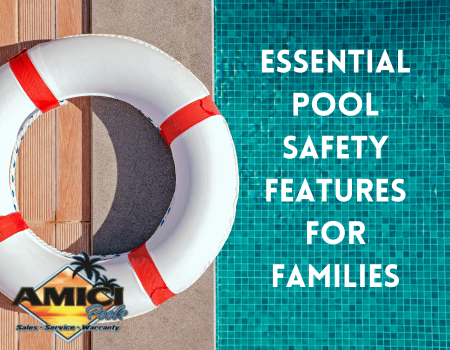A backyard pool is a great source of fun, exercise, and relaxation for families. However, without the right pool safety measures in place, it can also pose serious risks, especially for young children and pets. Drowning remains one of the leading causes of accidental deaths among children, making pool safety a top priority for families. Fortunately, by implementing essential safety features, you can create a secure swimming environment while still enjoying all the benefits of a pool.
Here are some of the most important pool safety features every family should consider.
Great Tips for Pool Safety
 1. Pool Fences: The First Line of Defense for Pool Safety
1. Pool Fences: The First Line of Defense for Pool Safety
A sturdy pool fence is one of the most effective ways to prevent unsupervised access to the pool. Many states and countries have regulations requiring fences around residential pools due to their proven effectiveness in reducing accidental drownings.
Key Features of a Safe Pool Fence:
- Height: A minimum of 4 feet (1.2 meters) high to prevent children from climbing over.
- Self-Closing and Self-Latching Gate: Ensures the gate remains closed and cannot be easily opened by young children.
- Vertical Bars: Spacing should be narrow enough to prevent a child from squeezing through.
- Climb-Resistant Material: Avoid horizontal bars or footholds that make it easy for children to climb.
Installing a pool fence is a simple yet powerful way to enhance safety and provide peace of mind for parents.
2. Pool Covers: Secure When Not in Use
A high-quality pool cover adds another layer of protection by preventing accidental falls into the water when the pool is not in use.
Types of Pool Covers:
- Safety Covers: These strong, reinforced covers can support the weight of a child or pet, preventing them from falling into the water.
- Automatic Covers: Operated with a switch or remote, these covers make it easy to secure the pool when not in use.
- Mesh Covers: Allow rainwater to pass through while keeping the pool securely covered.
A well-fitted safety cover can prevent accidents and also help maintain pool cleanliness by keeping debris out.
3. Pool Alarms: Early Warning Systems
Pool alarms provide an additional safety measure by alerting you to unexpected pool access. These alarms can detect movement in the water or when a gate is opened.
Types of Pool Alarms:
- Gate Alarms: Sound an alert when the pool gate is opened.
- Surface Wave Alarms: Detect disturbances on the water’s surface.
- Subsurface Alarms: Detect movement underwater, making them more reliable in preventing false alarms from wind or rain.
- Wearable Alarms: Designed for young children, these wristbands sound an alarm if they come into contact with water.
Using multiple types of alarms can provide comprehensive protection and ensure that you’re alerted to any potential danger.
4. Anti-Entrapment Drain Covers
Suction from pool drains can be extremely dangerous, trapping swimmers underwater. To prevent this, all pools should be equipped with anti-entrapment drain covers that meet safety standards.
How They Work:
- These specially designed covers prevent a strong suction force from forming, reducing the risk of a swimmer getting stuck.
- Dual drain systems can also help distribute suction more evenly, making it less likely for someone to become trapped.
Ensuring your pool’s drainage system is up to code is a crucial safety step for any family pool.
5. Slip-Resistant Pool Decking
Slips and falls are common around pools, especially with children running and playing nearby. Installing slip-resistant pool decking can help minimize the risk of injuries and is a simple way to maximize pool safety.
Safe Pool Decking Options:
- Textured Concrete: Provides grip while remaining durable and easy to maintain.
- Rubberized Pool Decking: Soft and slip-resistant, offering a cushioned surface for added safety.
- Natural Stone with Rough Finishes: Beautiful and functional, reducing the chances of slipping.
Encouraging kids to walk (not run) around the pool area is also essential for preventing falls.
6. Proper Pool Lighting for Nighttime Safety
A well-lit pool area is essential for visibility, especially if your family enjoys swimming in the evening. Poor lighting can increase the risk of slips, falls, and accidental missteps into the water.
Best Pool Lighting Options:
- Underwater LED Lights: Improve visibility in the pool.
- Pathway and Deck Lighting: Prevents tripping hazards around the pool area.
- Motion-Activated Lights: Automatically turn on when someone enters the pool area at night.
Ensuring the pool and its surroundings are properly illuminated can enhance both safety and aesthetics.
7. CPR and Emergency Equipment Readiness
Even with the best safety measures, accidents can still happen. Having emergency equipment readily available can make a critical difference in preventing a tragedy.
Essential Emergency Equipment:
- First Aid Kit: Stocked with bandages, antiseptics, and emergency supplies.
- Life Ring or Throw Rope: Can be used to assist a struggling swimmer.
- CPR Signage: A step-by-step CPR guide posted near the pool as a quick reference.
Additionally, all adults and older children in the household should be trained in CPR to respond effectively in an emergency.
A backyard pool can be a wonderful addition to family life, but safety should always come first. Implementing key pool safety features like fences, covers, alarms, and slip-resistant decking can significantly reduce risks and create a secure swimming environment.
